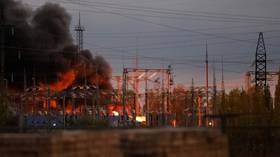Let's talk, Turkey: Downing of Russian SU-24 bomber just doesn't add up

The SU-24 supersonic bomber (NATO reporting name: Fencer), the kind that was shot down by a Turkish F16, is capable of traveling at about MACH 1.3. That’s almost one and a half times the speed of sound. That’s 1,654 KMH, and a bit less at sea level.
It’s unlikely to have been at maximum speed when it was shot down, so let’s assume it was at normal cruise speed, normally 75 percent of full power, which gives you about 1,200 kmh, give or take. So let’s be generous and say that it was traveling at about 1000 kmh, or just over 600 mph.
The Turkish authorities contend that in the five minutes before the attack, ten warnings were issued. According to all the maps, at its widest point, that little peninsular of Turkish land pushing into Syrian territory is about 5.39 km or 3.5 miles. Though if the incursion took place at all it is likely to have been further towards the tip.
At normal cruise speed (generously rounded down to 1000km) the alleged incursion would have lasted 19.4 seconds, barely enough time for a fast moving jet to take aim and lock on. Now let’s look at the 5 minutes of warnings that the Turks allege they gave the downed aircraft. Again, if we assume the same speed, the plane travelled 83 kilometers after the first warning and before the Turkish warplane fired.
Given the size of the little outcrop of Turkey into Syria and the apparent track of the aircraft, as confirmed by Turkish radar information, at the time the warning there could have been no indication that the SU24 would go near Turkish airspace. At that time it was travelling almost due east, again according to Turkish radar data. The testimony of the surviving crew member must also be taken into account. He is adamant that no warnings were received. It is possible of course that something was said on an obscure aviation frequency, but not the emergency frequency that all combat aircraft monitor as a matter of routine.
We are therefore asked to believe that an aircraft, in a known conflict zone, which was not at that time approaching Turkey’s border, was given a warning not to. Why would you tell an aircraft that isn’t heading towards your border not to cross it? By the time the Russian aircraft had turned onto a course that was certainly going to cross into Turkish airspace, there would have been less than a minute of time available to tell it not to. That minute (approximately) is critical!
As a NATO member, patrolling aircraft are not generally authorized to open fire at will. Instead, they report to base and await instructions. After having confirmed sighting, the SU24, the Turkish pilot would then have had to report to his controller on the ground. Someone at a Turkish Military base then had to make a decision and issue the order to engage and destroy. The pilot then has to lock the target into his weapons system and push the button to launch his air to air missiles. Thus, all of that had to have happened before the Russian actually penetrated Turkish air space.
The times involved make it impossible to believe otherwise. The alternative is to accept that the missile was fired after the Russian Jet had left Turkish airspace, by which time it is no longer a potential and so shooting it down would be contrary to NATO rules of engagement.
The actual incursion (if indeed there was one at all, which Moscow denies) lasted merely seconds. Media and online observers estimate anywhere between 10 and 17 seconds, the generous guess earlier allows a little more than that. Even so, not even 30 seconds would be enough to go through the launch authorizing process - lock on and fire – and then there’s the time it takes for the missiles to actually reach their target after they are fired. Not enough data is available to hazard a guess but it would take a good few seconds.

The alarming point is that even if there was an air space incursion - and let’s accept the possibility that there was - it was very brief and could not have been confirmed as probable any more than a minute or so at most before it happened. The decision to shoot it down therefore was taken an appreciable amount of time before the incursion. That being the case and given the distances and speeds involved, it would have happened anyway.
This brings the sequence of events into question. Normally and properly, a defending air force will first identify a potential threat at which point weapons may be armed. The threat must then be confirmed and seen to be a sustained threat to the defending country. That information is radioed back to tactical command who issue orders either to engage or to continue monitoring the situation. Given the speed and distances involved, the Turkish claims of repeated warnings just don’t stack up.
Let’s go back to speed and distance, basic stuff we all remember from school. At cruise speed, a jet fighter of any kind is likely to travel at around 800-1000 kmh, that’s more than 10 miles or 16 km per minute. This means, as we’ve established, if warnings were issued five minutes before the missile was launched, the “threat” aircraft would have been more than 50 miles (80 km) from the border. At that distance it would have been impossible to tell where the SU24 would have been in 5 minute’s time, especially considering that the Russian plane was, by the Turkish radar data, actually moving away from, or at least parallel to, the Turkish border.
There may of course be some margin for error in the details of the calculations above - a few decimal points have been rounded up or down for brevity and exact speed data is unknown - but the positions and courses followed by the two aircraft involved are pretty clear. But even here, there is margin for error.
As a pilot, I’m well aware of the ease with which positional errors can be made. Looking at the Turkish map, if the incursion took place, it was for a mere matter of seconds, and could easily have been the result of a very minor navigational error that in normal circumstances would make no difference whatsoever. I wish when I’m flying my navigation was so accurate as to be within a mile or two of my intended waypoint; it’s very easy to stray a mile north or south of your intended track for a whole variety of reasons. The Turkish air force will be as aware of this as I am.
The irreconcilable conclusion is that the decision to take down the Russian plane (perhaps even a Russian plane) has to have been taken appreciably before the alleged incursion. The question is, why?
It’s no secret that for nearly all Europeans who’ve chosen, for inexplicable reasons, to join ISIS in Syria, they do so by going to Turkey first. That includes alarming numbers of young women unbelievably dreaming of becoming Jihadi brides.
Another fact that is fairly widely known is that ISIS also has a well-trodden trade route by which to get its crude oil out of the areas it controls and onto the world market. That route too, or at least a good chunk of it, crosses Turkish borders and it is impossible to imagine that large quantities of crude oil can simply vanish into the processing plants without being noticed, unless of course there’s some sleight of hand being performed to legitimize the incoming crude. There are only two reasons that an official might agree to help “launder” a flow of oil - intimidation or financial gain. Most of the clever money is on the latter.
Russia on the other hand has been targeting ISIS with heavy bombardment and taking out oil convoys, depriving the extremists of income and presumably any middle men involved in the deal too. Perhaps that explains the true motive for taking out a Russian jet that, in turn, is involved in taking out a major income stream.
The perceived protection of NATO membership might give a sense of impunity but the rumor mill has it that Turkey’s NATO partners, while defending the action in public, are berating their wayward and junior member for a reckless and needless attack.
David Watson, for RT
LISTEN MORE:
The statements, views and opinions expressed in this column are solely those of the author and do not necessarily represent those of RT.















